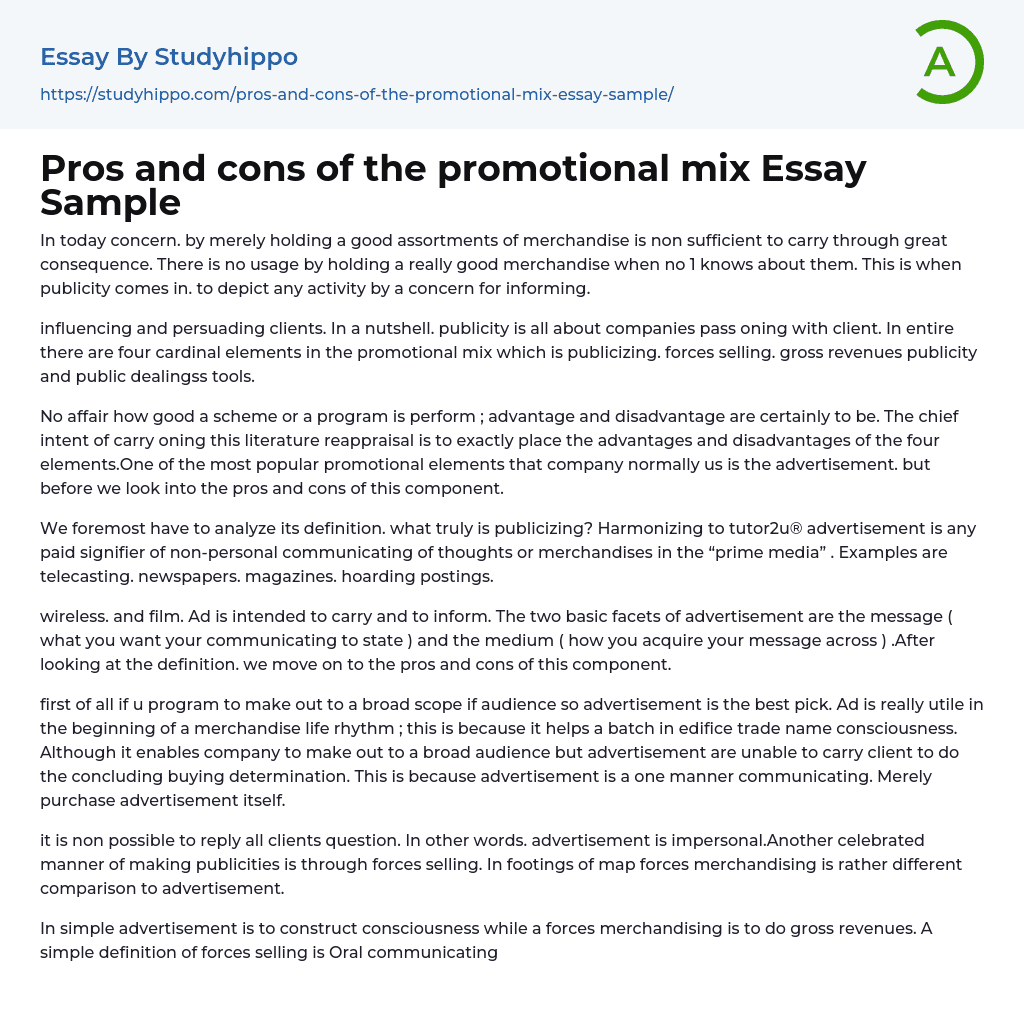Having a diverse range of products alone is inadequate for businesses to achieve significant outcomes in current times. Even if they have an excellent product, it is rendered useless if not widely known. Promotion is therefore essential for enterprises to disseminate information regarding their operations.
Communication with clients is the essence of publicity, which involves influencing and persuading them. The promotional mix comprises four main elements, namely advertising, sales promotion, public relations, and personal selling.
In order to fully assess the benefits and drawbacks of the four elements, it is crucial to acknowledge that each scheme or program has its own merits and limitations. Advertising is a widely utilized promotional component in businesses, therefore, conducting a literature review can provide comprehensive insight into both its favorable and unfavorable aspects.
To start off, it is essential to analyze the
...definition of advertising. What precisely does it entail? As per tutor2u®, advertising denotes all types of non-personal communication of concepts or items that are compensated for in the "prime media." These media encompass TV, newspapers, magazines, and billboards.
The purpose of transmitting information through film is the essence of advertising, which involves two key components: the message and the medium employed to deliver it. By comprehending this description, we can analyze both the merits and drawbacks of this feature.
If your goal is to broaden the reach of your programming, advertising is the optimal choice. Ads are especially valuable for generating brand awareness in a product's early stages. Although advertising can access a large audience, it cannot sway customers into making the final purchase decision since it operates as a one-way communication channel. Advertising is restricted to promoting the product through purchasing
advertisement space.
Advertising is impersonal, so it's not feasible to answer all customers' questions. Alternatively, sales representatives are a well-known method of reaching audiences. However, their role differs significantly from that of advertising in terms of functionality.
Essentially, advertising aims to increase awareness while sales promotion aims to increase sales. Sales promotion involves directly communicating with potential buyers in order to make a sale. Initially, personal selling may involve building a rapport with the potential buyer, but ultimately it always ends with an attempt to "close the sale". (Source: http://tutor2u.net/business/marketing/promotion_mix)
When using ASP, each component has its own strengths and weaknesses. For situations where a complex and detailed product needs to be explained, force selling is most advantageous. This is due to its highly interactive communication, allowing for two-way communication and providing answers to all customer inquiries. Not only does force selling facilitate sales, but it also helps build relationships.
Merchandising is the most efficient way to close sales when a long clip is needed due to the relationship built with customers. However, personnel selling can also be effective, but may have disadvantages in certain circumstances. Personnel selling tends to be more costly as it requires paying rewards to the salesperson and absorbing hidden costs.
A vast workforce is challenging to allocate in the market, making personnel merchandising unsuitable for businesses with thousands of important clients. To increase sales, companies can utilize sales promotion, which provides incentives to customers or distribution channels to stimulate demand for merchandise. One common example of sales promotion is in-store presentations.
When promoting sales, using competitions and monetary incentives such as 50% off and buy-one-get-one-free are effective methods for achieving a high success rate. These promotional
incentives targeted towards specific products can quickly increase sales.
Shopping complexes frequently use gross sales promotions to attract customers by offering significant discounts for a limited time. However, relying on sales promotions in the long term is not effective as customers become accustomed to them. While they initially increase sales quickly, excessive use of such promotions can harm the brand's image. Public relations, on the other hand, involves managing a company's reputation through media coverage to create the desired image.
The Chartered Institute of Marketing stated in 2001 that customer concern can be maintained by utilizing public relations, which is viewed as more credible because it originates from a third party. Moreover, it is less expensive than other elements in the promotional mix and has the potential to attract numerous customers if promoted effectively through suitable media channels. Nevertheless, public relations has its drawbacks since we have no authority over what others say or write about us. As a result, unfavorable news regarding our business may spread without any course of action available.
In decision-making, each element has both benefits and drawbacks. It's up to the seller to establish and implement an optimal marketing mix that boosts a company's brand recognition and revenue. Focusing solely on one area when promoting is not ideal; instead, we must strive for equilibrium across all aspects of the marketing mix in order to meet the product and company requirements.
- Sales Promotion essays
- Advertising campaign essays
- Chief Executive Officer essays
- Convenience Store essays
- Firm essays
- Training And Development essays
- Unilever essays
- Variable Cost essays
- Virgin Group essays
- Bargaining essays
- Entity essays
- Pest analysis essays
- Advertisement essays
- Advertising essays
- Anheuser-busch essays
- Audience Theory essays
- Brand essays
- Brands essays
- Competitor Analysis essays
- Consumer essays
- Detergent essays
- Marketing Management essays
- Marketing Mix essays
- Marketing Plan essays
- Marketing Research essays
- Marketing Strategy essays
- New Product Development essays
- Point Of Sale essays
- Price essays
- Procurement essays
- Product essays
- Product Differentiation essays
- Product Placement essays
- Promotion essays
- Promotion And Marketing Communications essays
- Research Design essays
- Retailing essays
- Trademark essays
- John Locke essays
- 9/11 essays
- A Good Teacher essays
- A Healthy Diet essays
- A Modest Proposal essays
- A&P essays
- Academic Achievement essays
- Achievement essays
- Achieving goals essays
- Admission essays
- Advantages And Disadvantages Of Internet essays
- Alcoholic drinks essays




